🎙️ Voice Activity Detection
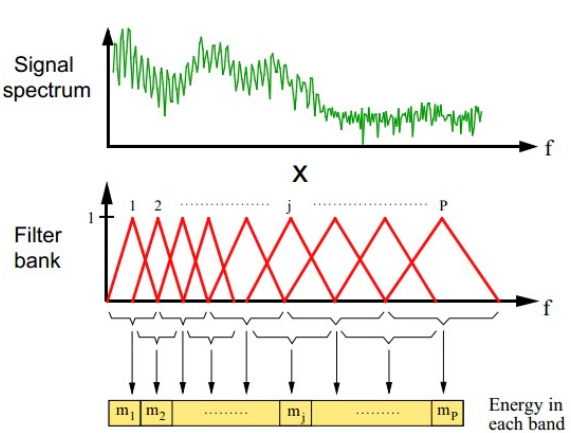 GitHub Repo: VAD
GitHub Repo: VADSummary
🎯 Voice Activity Detection (VAD), or voice endpoint detection, identifies time segments in an audio signal containing speech. This is a critical preprocessing step for automatic speech recognition (ASR) and voice wake-up systems. This project lays the groundwork for my upcoming ASR project 🤭.
📈 Workflow Overview: The VAD pipeline processes a speech signal as follows:
- Preprocessing: Apply pre-emphasis to enhance high-frequency components.
- Framing: Segment the signal into overlapping frames with frame-level labels.
- Windowing: Apply window functions to mitigate boundary effects.
- Feature Extraction: Extract a comprehensive set of features (e.g., short-time energy, zero-crossing rate, MFCCs, and more).
- Binary Classification: Train models (DNN, Logistic Regression, Linear SVM, GMM) to classify frames as speech or non-speech.
- Time-Domain Restoration: Convert frame-level predictions to time-domain speech segments.
🍻 Project Highlights:
I conducted extensive experiments comparing frame division methods (frame length and shift) and model performances, with rich visualizations. For details, see the report in vad/latex/. If you’re interested in voice technologies, let’s connect!
For Chinese report, please see this article.
Methodology
1. Preprocessing
Pre-emphasis enhances high-frequency components to reduce spectral leakage.
$$ y[n] = x[n] - \alpha x[n-1] $$where $x[n]$ is the input signal, $y[n]$ is the output, and $\alpha$ (typically 0.95–0.97) controls emphasis strength.
Pre-emphasis Impact:
Effect of pre-emphasis with varying $\alpha$
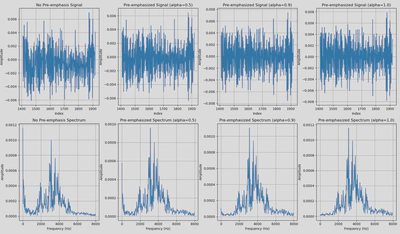
2. Framing
The signal is divided into overlapping frames. For signal length $N$, frame length $L$, and frame shift $S$, the number of frames $n_{\text{frames}}$ is:
Without zero-padding (floor):
$$ n_{\text{frames}} = \left\lfloor \frac{N - L}{S} \right\rfloor + 1 $$With zero-padding (ceiling):
$$ n_{\text{frames}} = \left\lceil \frac{N - L}{S} \right\rceil + 1 $$Zero-padding length:
$$ n_{\text{paddle}} = (n_{\text{frames}} - 1) \cdot S + L - N $$
3. Windowing
A window function (e.g., Hamming) is applied to each frame.
$$ x_i^{\text{windowed}}[n] = x_i[n] \cdot w[n], \quad 0 \leq n < L $$Window Type Comparison:
Impact of window functions (e.g., Hamming, Hanning)

4. Feature Extraction
Extracted features (total dimension: 69) include:
Short-Time Energy (dimension: 1):
Measures frame energy, indicating loudness:
$$ E = \sum_{i=0}^{L-1} s_i^2 $$where $s_i$ is the $i$-th sample in the frame, and $L$ is the frame length.
Frame-level energy plots:

Short-Time Zero-Crossing Rate (dimension: 1):
Counts zero crossings to distinguish voiced/unvoiced speech:
$$ Z = \frac{1}{2} \sum_{i=0}^{L-1} \left| \text{sgn}(s_i) - \text{sgn}(s_{i-1}) \right|, \quad \text{sgn}(x) = \begin{cases} 1, & x \geq 0 \\ 0, & x < 0 \end{cases} $$Visualizing zero-crossing patterns:

Fundamental Frequency (Pitch) (dimension: 1):
Estimated via autocorrelation, representing the fundamental frequency:
$$ R(\tau) = \sum_{n=0}^{L-1-\tau} s[n] s[n+\tau], \quad f_0 = \frac{f_s}{\tau_{\text{max}}} $$where $R(\tau)$ is the autocorrelation, $\tau_{\text{max}}$ is the lag maximizing $R(\tau)$, $f_s$ is the sampling frequency (16 kHz), and $s[n]$ is the frame signal.
And I have tried many smooth methods, see it in my report.
Spectral Mean (dimension: 1):
Indicates the spectral “center of mass”
$$ \mu_n = \frac{\sum_{k=1}^K\mid X(n, k)\mid}{K} $$where $X(n, k)$ is the Fourier transform magnitude at bin $k$ in $n-$th frame, and $K$ is the number of bins.

Sub-band Energies (dimension: 6):
$$ E_m = \sum_{k \in B_m} |S(k)|^2, \quad m = 1, 2, \ldots, 6 $$where $B_m$ is the set of frequency bins in the $m$-th sub-band.
Energy in 6 frequency sub-bands
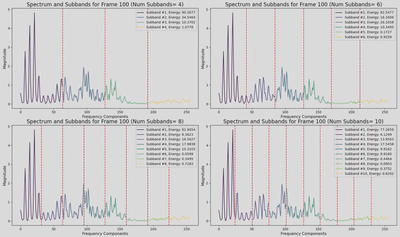
Filter Banks (FBanks) (dimension: 23):
$$ E_m = \sum_{k=0}^{K-1} |S(k)|^2 H_m(k), \quad m = 1, 2, \ldots, 23 $$where $H_m(k)$ is the $m$-th mel filter’s frequency response, and the mel scale is:
$$ \text{mel}(f) = 2595 \log_{10}\left(1 + \frac{f}{700}\right) $$Mel-scale filter bank energies

Mel-Frequency Cepstral Coefficients (MFCCs) (dimension: 12):
Cepstral coefficients from mel filter banks:
$$ c_n = \sum_{m=1}^{M} \log E_m \cos\left( n \left(m - 0.5\right) \frac{\pi}{M} \right), \quad n = 1, 2, \ldots, 12 $$where $E_m = \sum_{k=0}^{K-1} |S(k)|^2 H_m(k)$ is the $m$-th filter bank energy, and $M = 23$.
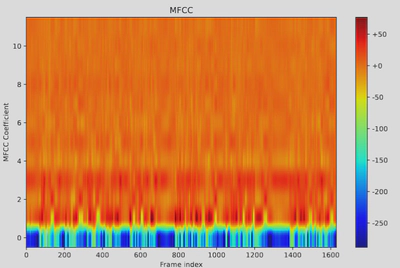
Delta MFCCs (dimension: 12): First-order differences of MFCCs:
$$ \Delta c_n(t) = \frac{\sum_{d=1}^D d \left( c_n(t shap-d) - c_n(t-d) \right)}{2 \sum_{d=1}^D d^2}, \quad n = 1, 2, \ldots, 12 $$where $c_n(t)$ is the $n$-th MFCC at frame $t$, and $D$ is the window size (typically 2–3).
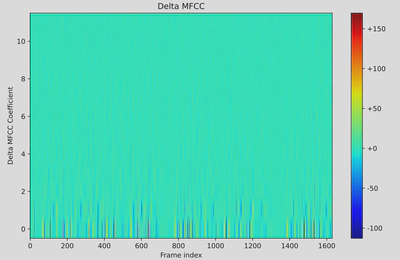
Delta-Delta MFCCs (dimension: 12):
Second-order differences:
$$ \Delta^2 c_n(t) = \frac{\sum_{d=1}^D d \left( \Delta c_n(t+d) - \Delta c_n(t-d) \right)}{2 \sum_{d=1}^D d^2}, \quad n = 1, 2, \ldots, 12 $$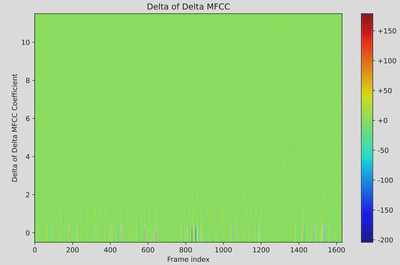
5. Classification Models
models I trained trained:
Deep Neural Network (DNN):
- Architecture: Input (69) → 64 (ReLU, Dropout 0.5) → 32 (ReLU, Dropout 0.5) → 16 (ReLU, Dropout 0.5) → 1 (Sigmoid).
- Loss: Binary Cross-Entropy.
- Training: 10 epochs, Adam optimizer.
Logistic Regression
- Use sklearn()
Linear Support Vector Machine (SVM):
- Use sklearn()
Gaussian Mixture Model (GMM):
- Construct by myself
- Models classes as Gaussian mixtures
- Trained with Expectation-Maximization.
- Its performance is not so good, I will spare some time to figure it out.
6. Experimental Results
Models were tested with frame lengths (320–4096) and shifts (80–2048). DNN outperformed others (frame length 4096, shift 1024):
| Model | AUC | EER | Accuracy | Precision | Recall | F1 Score |
|---|---|---|---|---|---|---|
| DNN | 0.9876 | 0.0464 | 0.9603 | 0.9765 | 0.9749 | 0.9757 |
| Logistic Regression | 0.9457 | 0.1134 | 0.9432 | 0.9347 | 0.9389 | 0.9368 |
| Linear SVM | 0.8937 | 0.9413 | 0.1170 | 0.9349 | 0.9352 | 0.9350 |
7. Visualization on time domain division
I restored the framed labels back to the time domain and visualized them as follows:
Usage
- Clone the repository:
git clone https://github.com/xuankunyang/Voice-Activity-Detection.git - Install dependencies:
pip install -r requirements.txt - Extract the features first and train a binary classifier, predict, time-domain restoration, visulize the time division. Considering the space limit, I couldn’t put my pre-trained models here, but its not difficult to implement all above using this framework.
- Explore visualizations in
vad/latex/figs/and the report.
Contributing
Fork the repository, create a branch, and submit pull requests. For major changes, open an issue.
License
Licensed under the MIT License. See LICENSE.
Contact
Reach out via email or GitHub issues.